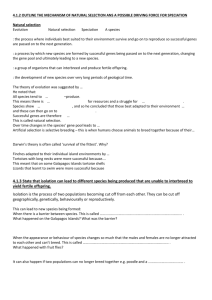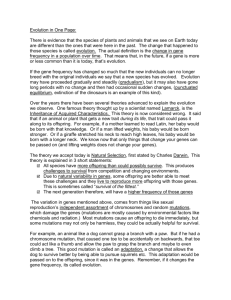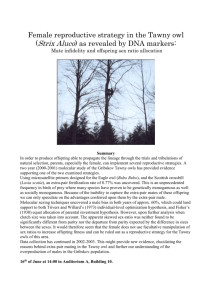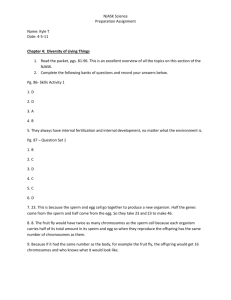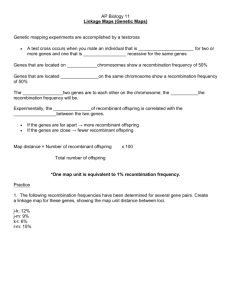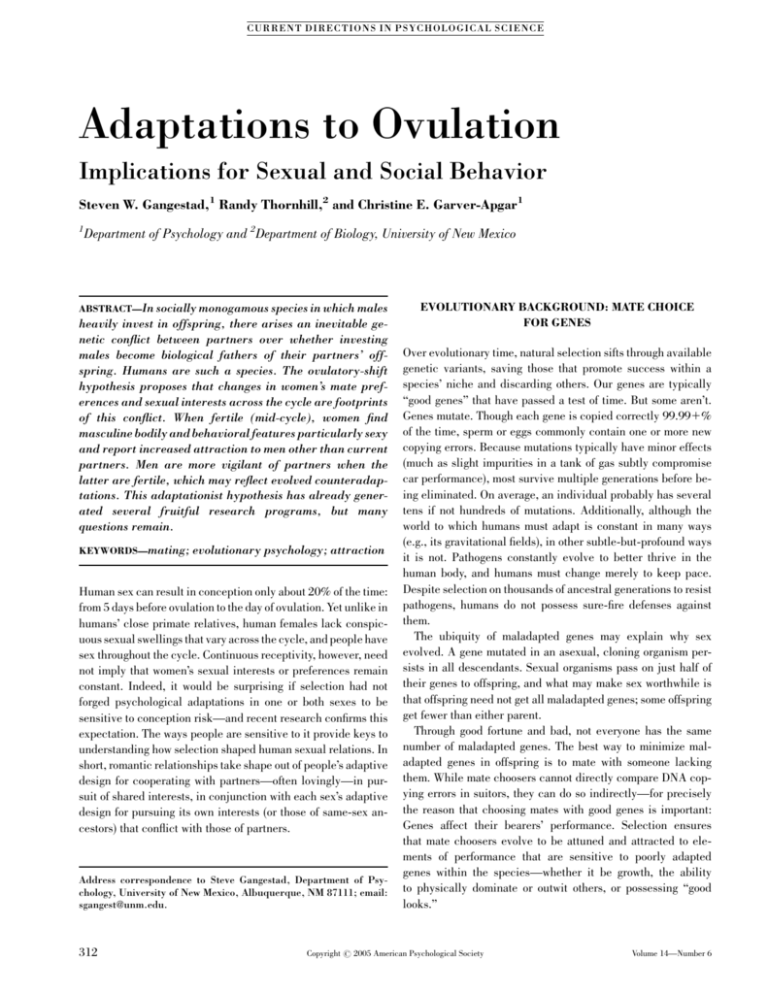
CURRENT DIRECTIONS IN PSYCHOLOGICAL S CIENCE
Adaptations to Ovulation
Implications for Sexual and Social Behavior
Steven W. Gangestad,1 Randy Thornhill,2 and Christine E. Garver-Apgar1
1
Department of Psychology and 2Department of Biology, University of New Mexico
ABSTRACT—In socially monogamous species in which males
heavily invest in offspring, there arises an inevitable genetic conflict between partners over whether investing
males become biological fathers of their partners’ offspring. Humans are such a species. The ovulatory-shift
hypothesis proposes that changes in women’s mate preferences and sexual interests across the cycle are footprints
of this conflict. When fertile (mid-cycle), women find
masculine bodily and behavioral features particularly sexy
and report increased attraction to men other than current
partners. Men are more vigilant of partners when the
latter are fertile, which may reflect evolved counteradaptations. This adaptationist hypothesis has already generated several fruitful research programs, but many
questions remain.
KEYWORDS—mating;
evolutionary psychology; attraction
Human sex can result in conception only about 20% of the time:
from 5 days before ovulation to the day of ovulation. Yet unlike in
humans’ close primate relatives, human females lack conspicuous sexual swellings that vary across the cycle, and people have
sex throughout the cycle. Continuous receptivity, however, need
not imply that women’s sexual interests or preferences remain
constant. Indeed, it would be surprising if selection had not
forged psychological adaptations in one or both sexes to be
sensitive to conception risk—and recent research confirms this
expectation. The ways people are sensitive to it provide keys to
understanding how selection shaped human sexual relations. In
short, romantic relationships take shape out of people’s adaptive
design for cooperating with partners—often lovingly—in pursuit of shared interests, in conjunction with each sex’s adaptive
design for pursuing its own interests (or those of same-sex ancestors) that conflict with those of partners.
Address correspondence to Steve Gangestad, Department of Psychology, University of New Mexico, Albuquerque, NM 87111; email:
sgangest@unm.edu.
312
EVOLUTIONARY BACKGROUND: MATE CHOICE
FOR GENES
Over evolutionary time, natural selection sifts through available
genetic variants, saving those that promote success within a
species’ niche and discarding others. Our genes are typically
‘‘good genes’’ that have passed a test of time. But some aren’t.
Genes mutate. Though each gene is copied correctly 99.991%
of the time, sperm or eggs commonly contain one or more new
copying errors. Because mutations typically have minor effects
(much as slight impurities in a tank of gas subtly compromise
car performance), most survive multiple generations before being eliminated. On average, an individual probably has several
tens if not hundreds of mutations. Additionally, although the
world to which humans must adapt is constant in many ways
(e.g., its gravitational fields), in other subtle-but-profound ways
it is not. Pathogens constantly evolve to better thrive in the
human body, and humans must change merely to keep pace.
Despite selection on thousands of ancestral generations to resist
pathogens, humans do not possess sure-fire defenses against
them.
The ubiquity of maladapted genes may explain why sex
evolved. A gene mutated in an asexual, cloning organism persists in all descendants. Sexual organisms pass on just half of
their genes to offspring, and what may make sex worthwhile is
that offspring need not get all maladapted genes; some offspring
get fewer than either parent.
Through good fortune and bad, not everyone has the same
number of maladapted genes. The best way to minimize maladapted genes in offspring is to mate with someone lacking
them. While mate choosers cannot directly compare DNA copying errors in suitors, they can do so indirectly—for precisely
the reason that choosing mates with good genes is important:
Genes affect their bearers’ performance. Selection ensures
that mate choosers evolve to be attuned and attracted to elements of performance that are sensitive to poorly adapted
genes within the species—whether it be growth, the ability
to physically dominate or outwit others, or possessing ‘‘good
looks.’’
Copyright r 2005 American Psychological Society
Volume 14—Number 6
Steven W. Gangestad, Randy Thornhill, and Christine E. Garver-Apgar
In relatively few species do both females and males intensively
nurture offspring. Humans may be one. While questions remain
about how and to what extent men nurture their own offspring in
foraging societies, in most societies men and women typically
form socially monogamous pairs and men attempt to direct resources (meat, protection, direct care, money) to mates and
offspring. Chimpanzees, bonobos, and gorillas don’t share this
pattern and are probably poor models of human sexual relations.
As many bird species form social pairs, however, theories about
their mating may offer insight into how selection shaped human
sexual psychologies.
Many socially monogamous birds are not sexually monogamous. On average across species, 10 to 15% of offspring are
fathered by males other than social partners—so-called ‘‘extrapair’’ males. Multiple reasons that females seek extra-pair mates
are being investigated, but one is that male assistance in raising
offspring doesn’t eliminate selection pressure on females to
obtain good genes. Not all females can pair up with males with
high genetic fitness. Those who don’t could potentially benefit
from getting social partners’ cooperation in raising offspring but
getting other males’ genes. This pattern has been elegantly
demonstrated in the collared flycatcher. A large male forehead
patch advertises good genes. Females don’t prefer large-patched
males as social partners, as they work less hard at the nest.
Small-patched males, however, are more likely to be cuckolded
and large-patched males the biological fathers. Indeed, females
time extra-pair copulations to occur during peak fertility, favoring paternity by extra-pair partners.
More generally, in socially monogamous species in which
pairs have males as close neighbors, an inevitable conflict between the sexes arises. All else being equal, females mated to
males not possessing the best genes could benefit by getting
genes from someone else. At the same time, selection operates on
investing males to prevent cuckoldry (e.g., by mate guarding or
being able to recognize offspring not their own). Selection hence
operates on each sex against the interests of the other sex; thus
‘‘sexually antagonistic adaptations’’ evolve. Depending on which
sex evolves more effective adaptations (which may depend on
ecological factors affecting the ease with which males guard
their mates, the relative value of good genes, the amount of
assistance males give females, etc.), the actual extra-pair sex
rate may be high (20% or more) or low (5% or less). Even when it
is low, however, the genetic conflict exists and sexually antagonistic adaptations may evolve.
THE OVULATORY-SHIFT HYPOTHESIS
We (Gangestad & Thornhill, 1998) proposed to look for human
adaptations that are footprints of these selection forces, based on
the fact we began with: Women are fertile during a brief window
Volume 14—Number 6
of their cycles. If ancestral females benefited from multiple
mating to obtain genetic benefits but at some potential cost of
losing social mates, selection may have shaped preferences for
indicators of those benefits to depend on fertility status: maximal
at peak fertility and less pronounced outside the fertile period.
Cycle shifts should furthermore be specific to when women
evaluate men as short-term sex partners (i.e., their ‘‘sexiness’’)
rather than as long-term, investing mates (Penton-Voak et al., 1999).
The logic is that costs do not pay when benefits cannot be reaped.
Over a dozen recent studies show that female preferences
clearly do shift. At mid-cycle, normally ovulating, non-pill-using
women particularly prefer physical symmetry, masculine facial
and vocal qualities, intrasexual competitiveness, and various
forms of talent.
The scent of symmetrical men. Asymmetry on bilateral traits
that are symmetrical at the population level (e.g., finger lengths,
ear dimensions, wrist width) reflects developmental instability,
perturbations due to mutations, pathogens, toxins, and other
stresses. Developmental instability, in turn, could affect numerous other features of men, including their scent. In four
studies, men wore tee-shirts for two nights and women rated the
attractiveness of the shirts’ scents. All studies found that, when
they were fertile, women particularly preferred the scent of
symmetrical men (see Fig. 1). When women were not fertile, they
had no preference for symmetrical men’s scents. Although the
chemical mediating this effect has not been identified, data and
theory suggest the existence of androgen-derived substances,
the scent of which women evaluate more positively when fertile.
Masculine faces. Male and female faces differ in various ways.
Most notably, men have broader chins and narrower eyes (due to
development of the brow ridge). Men vary, however, in the extent
to which they possess masculine facial features. Women’s preference for more masculine faces is more pronounced when they
are fertile than when they are infertile, particularly when they
follicular phase
0.6
Preference for Symmetry
TRADE-OFFS BETWEEN MATERIAL AND GENETIC
BENEFITS
luteal phase
0.5
0.4
0.3
0.2
0.1
0
−0.1
0
10
20
Day in Cycle
30
Fig. 1. Women’s preference for the scent of symmetrical men as a function
of their day in the cycle (N 5 141). The vertical line corresponds to
women’s average day of ovulation. The follicular and luteal phases precede
and follow ovulation, respectively. Each woman’s ratings of scent attractiveness (a sum of ratings of pleasantness and sexiness) were measured
against men’s physical symmetry. Data are compiled from three separate
studies: Gangestad & Thornhill (1998), Thornhill & Gangestad (1999),
and Thornhill et al. (2003).
313
Adaptations to Ovulation
short-term
Preference for SP/DIC
0.2
long-term
0.15
0.1
0.05
0
−0.05
1
6
11
16
21
26
Day of the Cycle
Fig. 2. Women’s preference for men who display social presence (SP) and
direct intrasexual competitiveness (DIC) as short-term partners (solid line)
and as long-term partners (dotted line), as a function of day of their cycle
(N 5 238). From Gangestad et al. (2004).
rate men’s sexiness, not their attractiveness as long-term mates
(e.g, Penton-Voak et al., 1999; Johnston, Hagel, Franklin, Fink,
& Grammer, 2001).
Behavioral displays of social presence and intrasexual competitiveness. We (Gangestad, Simpson, Cousins, Garver-Apgar, &
Christensen, 2004) had women view videotapes of men being
interviewed for a potential lunch date. Men independently rated
as confident and who acted toward their male competitors in
condescending ways were found more sexy by women when the
women were fertile than they were when the women were not
fertile (see Fig. 2).
Vocal masculinity. When rating men’s short-term attractiveness, women find masculine (deep) voices more attractive at
mid-cycle than they do at other times (Puts, 2005).
Talent versus wealth. Haselton and Miller (in press) found that,
when faced with trade-offs between talent (e.g., creativity) and
wealth, women choose talent more often when fertile than they do
when nonfertile, but only when evaluating men’s short-term
mating attractiveness.
All of these characteristics may well have been indicators of
good genes ancestrally. Not all positive traits are sexier midcycle, however. Traits particularly valued in long-term mates
(e.g., promising material benefits) do not appear to be especially
attractive to fertile women. For instance, follow-up analyses
showed that while the women in the Gangestad et al. (2004)
study found arrogant, confrontative, and physically attractive
men particularly sexy mid-cycle, their attraction to men perceived to be kind, intelligent, good fathers, and likely to be financially successful—traits particularly valued in long-term
mates—didn’t change across the cycle. And men judged to be
faithful were rated as less sexy mid-cycle than at other times (see
also Thornhill et al., 2003).
SHIFTS IN WOMEN’S SEXUAL INTERESTS
Patterns of women’s sexual interests also shift across the cycle.
In one study, normally ovulating women reported thoughts and
314
feelings over the previous 2 days twice: once when fertile (as
confirmed by a luteinizing hormone surge, 1–2 days before
ovulation) and once when infertile. When fertile, women reported greater sexual attraction to and fantasy about men other
than their primary partners than they did at other times—but
their level of attraction to primary partners at this time was no
greater than it was when they were infertile (Gangestad,
Thornhill, & Garver, 2002; cf. Pillsworth, Haselton, & Buss,
2004).
In fact, however, the ovulatory-shift hypothesis expects a more
finely textured pattern. On average, ancestral women could have
garnered genetic benefits through extra-pair mating, but those
whose primary partners had good genes could not. Selection thus
should have shaped interest in extra-pair men mid-cycle to itself
depend on partner features; only women with men who, relatively speaking, lack purported indicators of genetic benefits
should be particularly attracted to extra-pair men when fertile.
We (Gangestad, Thornhill, & Garver-Apgar, 2005) tested this
prediction in a replication and extension of Gangestad et al.
(2002). Romantically involved couples participated. Again, individuals privately filled out questionnaires twice, once when
the female was fertile and once during her luteal phase. Men’s
symmetry was measured. Once again, women reported greater
attraction to extra-pair men and not their primary partners when
fertile. Effects, however, were moderated by the symmetry of
women’s partners. At high fertility, women with relatively
asymmetrical partners were more attracted to extra-pair men—
and less attracted to their own partners—than when they were
infertile. No such effects were found during the luteal phase.
Controlling for relationship satisfaction, another important
predictor of women’s attraction to extra-pair men, did not
diminish the effect of partner symmetry. (See also Haselton &
Gangestad, in press.)
MALE COUNTERSTRATEGIES ACROSS THE CYCLE
If women have been under selection to seek good genes midcycle, men should have been under selection to take additional
steps to prevent them from seeking extra-pair sex at this time.
Multiple studies indicate that they do so by being more vigilant,
proprietary, or monopolizing of mates’ time during those times
(e.g., Gangestad et al., 2002; Haselton & Gangestad, in press).
There are several candidate cues of fertility status men might
use. Three studies found that men find the scent of ovulating
women particularly attractive (e.g., Thornhill et al., 2003) and
one found that men judge women’s faces more attractive midcycle. If women’s interests change across the cycle, their behavior might too. Whatever the cues, women are unlikely to have
been designed through selection to send them. As noted at the
outset, women do not have obvious sexual swellings mid-cycle,
and they have sex throughout the cycle. These features may well
be due to selection on women to suppress signs of fertility status.
Men, nonetheless, should be selected to detect byproducts of
Volume 14—Number 6
Steven W. Gangestad, Randy Thornhill, and Christine E. Garver-Apgar
fertility status not fully suppressed. Consistent with this idea, we
(Gangestad et al., 2002) found that enhanced male vigilance of
partners mid-cycle (as reported by women) was predicted by
enhanced female interest in extra-pair men and not their partners. Men may be particularly vigilant of their partners midcycle, when their partners least want them to be.
ADDITIONAL OVULATORY ADAPTATIONS AND
BYPRODUCTS
Women’s preferences and biases may shift not only toward certain men, but away from clearly undesirable mating options (e.g.,
incest, rape; e.g., Chavanne & Gallup, 1998). Fessler and Navarrete (2003) assessed women’s disgust in several domains:
maladaptive sex such as incest and bestiality, food aversiveness,
and filth. Only disgust to maladaptive sex rose with fertility.
Women can identify male faces as male more quickly when
fertile (e.g., Macrae, Alnwick, Milne, & Schloerscheidt, 2002).
This effect is perhaps a byproduct of greater salience of masculine features in male faces associated with their preference
when women are fertile. Adaptive ovulatory shifts in preferences, sexual interests, and biases may produce a variety of other
byproducts.
CONCLUSION
In any socially monogamous species in which males heavily
invest in offspring, there is an inevitable genetic conflict between partners over where the female obtains genes for her offspring. Changes across the ovulatory cycle in women’s and men’s
behavior may contain telltale signs of this conflict.
Many questions remain unanswered. Which female mate
preferences strengthen mid-cycle; which don’t? Is the pattern
consistent with the good-genes hypothesis? Some preferences
may be for compatible genes, ones that complement those of the
mate chooser (e.g., dissimilar major histocompatibility complex
[MHC] genes). Are preferences for compatibility maximal midcycle (see Thornhill et al., 2003)? How do male-partner features
(e.g., symmetry, MHC dissimilarity) or relationship characteristics (e.g., satisfaction) affect female sexual interest mid-cycle?
Do cycle shifts endure across women’s reproductive lifespan?
Are they robust across human populations? How, precisely, do
men behave differently toward fertile partners and what cues
mediate changes? Do women resist partners’ proprietary actions
more mid-cycle? What proximate mechanisms (e.g., hormones)
mediate cycle shifts? (Changes in female preferences for the
scent of symmetrical men are best predicted by corresponding
changes in women’s testosterone [positively] and progesterone
[negatively], but other candidates [e.g., estrogen, luteinizing
hormone] are possible.) Do men’s hormones (e.g., testosterone)
fluctuate in response to female partners’ ovulatory status?
An evolutionary approach uniquely views ovulation as a
highly important event around which psychological adaptations
Volume 14—Number 6
might evolve. Alternative nonevolutionary approaches could not
have predicted a priori or accounted for these findings. More
generally, then, the ovulatory-shift hypothesis illustrates the
heuristic value of an adaptationist perspective, guiding researchers to explore domains otherwise unexplored and generating fruitful predictions not offered by other approaches.
Recommended Reading
Gangestad, S.W., Thornhill, R., & Garver-Apgar, C.E. (in press). Adaptations to ovulation. In D.M. Buss (Ed.), Evolutionary Psychology Handbook. Boston: Allyn-Bacon.
Jennions, M.D., & Petrie, M. (2000). Why do females mate multiply?:
A review of the genetic benefits. Biological Reviews, 75, 21–64.
Kappeler, P.M., & van Schaik, C.P. (Eds.) (2004). Sexual selection in
primates: New and comparative perspectives. Cambridge, U.K.:
Cambridge University Press.
Rice, W.R., & Holland, B. (1997). The enemies within: Intragenomic
conflict, interlocus contest evolution (ICE), and the intraspecific
Red Queen. Behavioral Ecology and Sociobiology, 41, 1–10.
REFERENCES
Chavanne, T.J., & Gallup, G.G. (1998). Variation in risk taking behavior
among female college students as a function of the menstrual cycle. Evolution and Human Behavior, 19, 27–32.
Fessler, D.M.T., & Navarrete, C.D. (2003). Domain-specific variation
in disgust sensitivity across the menstrual cycle. Evolution and
Human Behavior, 324, 406–417.
Gangestad, S.W., Simpson, J.A., Cousins, A.J., Garver-Apgar, C.E., &
Christensen, P.N. (2004). Women’s preferences for male behavioral displays change across the menstrual cycle. Psychological
Science, 15, 203–207.
Gangestad, S.W., & Thornhill, R. (1998). Menstrual cycle variation in
women’s preference for the scent of symmetrical men. Proceedings
of the Royal Society of London, B, 262, 727–733.
Gangestad, S.W., Thornhill, R., & Garver, C.E. (2002). Changes in
women’s sexual interests and their partners’ mate retention tactics
across the menstrual cycle: Evidence for shifting conflicts of interest. Proceedings of the Royal Society of London, B, 269, 975–
982.
Gangestad, S.W., Thornhill, R., & Garver-Apgar, C.E. (2005). Female
sexual interests across the ovulatory cycle depend on primary
partner developmental instability. Proceedings of the Royal Society
of London, B, 272, 2023–2027.
Haselton, M.G., & Gangestad, S.W. (in press). Conditional expression of
female desires and male mate retention efforts across the human
ovulatory cycle. Hormones and Behavior.
Haselton, M.G., & Miller, G.F. (in press). Evidence for ovulatory shifts
in attraction to artistic and entrepreneurial excellence. Human
Nature.
Johnston, V.S., Hagel, R., Franklin, M., Fink, B., & Grammer, K. (2001).
Male facial attractiveness: Evidence for hormone mediated
adaptive design. Evolution and Human Behavior, 23, 251–267.
Macrae, C.N., Alnwick, K.A., Milne, A.B., & Schloerscheidt, A.M.
(2002). Person perception across the menstrual cycle: Hormonal
influences on social-cognitive functioning. Psychological Science,
13, 532–536.
315
Adaptations to Ovulation
Penton-Voak, I.S., Perrett, D.I., Castles, D., Burt, M., Kobayashi, T., &
Murray, L.K. (1999). Female preference for male faces changes
cyclically. Nature, 399, 741–742.
Pillsworth, E.G., Haselton, M.G., & Buss, D.M. (2004). Ovulatory shifts
in female sexual desire. Journal of Sex Research, 41, 55–65.
Puts, D.A. (2005). Mating context and menstrual phase affect women’s
preference for male voice pitch. Evolution and Human Behavior,
26, 388–397.
316
Thornhill, R., & Gangestad, S.W. (1999). The scent of symmetry: A
human pheromone that signals fitness? Evolution and Human
Behavior, 20, 175–201.
Thornhill, R., Gangestad, S.W., Miller, R., Scheyd, G., McCollough, J.,
& Franklin, M. (2003). MHC, symmetry and body scent attractiveness in men and women (Homo sapiens). Behavioral Ecology,
14, 668–678.
Volume 14—Number 6

